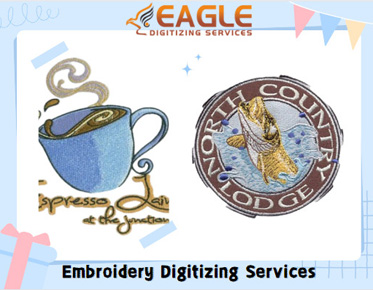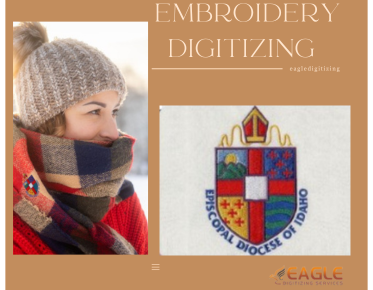Patches Reimagined: Digitized Embroidery for Patches Will It Work?
Patches have made a remarkable resurgence in the realms of fashion and DIY. From denim jackets adorned with artistic designs to backpacks embellished with quirky patches, they add a personal touch that transforms the mundane into the extraordinary. Not only do they serve as expressions of individuality, but they also provide a canvas for creativity. As a result, more people are embracing the idea of customizing their clothing and accessories, making patches a staple in modern wardrobes. If this post spurred your interest and you want to find out more about embroidery digitizing, please feel free to contact us.
The Benefits of Digitized Embroidery for Patches
Consistency: The Key to Professional Quality
Digitized embroidery revolutionizes patch production by ensuring unparalleled consistency. Once a design is digitized, it can be replicated countless times with the same level of detail and precision. This is especially crucial for businesses aiming to maintain a cohesive brand image across various products. No more discrepancies between patches; each piece emerges from the machine as a mirror of the last, elevating the quality of your work to professional standards.
Precision and Detail: Capturing Intricate Designs
Gone are the days when intricate designs were relegated to the realm of fantasy due to the limitations of manual embroidery. Digitized embroidery allows for astonishing precision, enabling artisans to capture even the most delicate details. Fine lines, intricate patterns, and tiny text can all be rendered beautifully. This capability opens the door to complex artwork that would have previously been impractical, allowing creators to push the boundaries of their designs.
Speed: How Digitization Speeds Up Production
In an economy where time equals money, quickness is crucial. Digitized embroidery significantly accelerates the production process. Once the design is digitized, the embroidery machine can work at a swift pace, stitching out designs in a fraction of the time it would take to complete them manually. This efficiency allows businesses to fulfill larger orders promptly, keeping customers satisfied and profits soaring.
Choosing the Right Software
Overview of Popular Digitizing Software
Selecting the appropriate software is essential when digitizing embroidered patterns. Options abound, from industry giants like Wilcom and Hatch to user-friendly platforms like SewArt and Ink/Stitch. Every software has special features designed for varying skill levels and project needs. Understanding the landscape of digitizing software will help you make an informed decision.
Comparing Features: Which One is Right for You?
When evaluating digitizing software, consider the features that align with your goals. Some programs boast advanced editing capabilities, while others prioritize ease of use. Look for features like automatic stitch generation, customization options, and file format compatibility. By pinpointing what you need, you can select software that enhances your workflow rather than complicating it.
Tips for Beginners: What to Look for in Software
For beginners, simplicity is key. Opt for software that offers intuitive interfaces and straightforward tutorials. Look for programs that provide a library of pre-made designs to help you get started. Additionally, check for supportive communities or customer service resources, as these can be invaluable as you navigate the learning curve.
Preparing Your Artwork for Digitization
File Formats: What Works Best?
The file format you choose can significantly impact the digitizing process. Most software supports formats like .jpg, .png, and .svg, but vector files (like .ai or .eps) are often preferred for their scalability and clarity. Vector images allow for seamless scaling without loss of detail, ensuring your designs look crisp and professional.
Designing with Embroidery in Mind: Key Considerations
When designing artwork for digitization, certain considerations must be made. Simplicity is crucial; complex designs may not translate well into stitches. Aim for bold lines and clear shapes that can be easily interpreted by the embroidery machine. Also, keep in mind the size and placement of your design, as these factors will influence the overall aesthetic of the finished patch.
How to Simplify Complex Designs for Better Results
To simplify intricate designs, start by breaking them down into their basic components. Identify key elements that capture the essence of the design, and remove unnecessary details that may clutter the final result. Utilizing solid shapes and clear outlines can also help ensure that your design is both visually appealing and practical for embroidery.
The Digitizing Process
Step-by-Step Guide to Digitizing a Patch Design
1. Import your Artwork: Begin by importing your artwork into your chosen software.
2. Convert to Vector: If your design is not already in vector format, use the software's tracing tool to convert it.
3. Select Stitch Types: Choose the stitch types that best suit your design. Common options include satin, fill, and running stitches.
4. Outline the Design: Create outlines for each section of your design, ensuring they are properly layered.
5. Adjust Parameters: Set parameters like stitch density and underlay according to the fabric you’ll be using.
6. Preview the Design: Use the preview function to visualize how the embroidery will look.
Choosing Stitch Types and Techniques
Selecting the right stitch types is vital for the final look of your patch. Satin stitches offer a smooth finish ideal for lettering and fine details, while fill stitches work well for larger areas. Experiment with different techniques, like running stitches or decorative stitches, to find the perfect balance between aesthetics and functionality.
Adjusting Density and Underlay for Optimal Results
Stitch density affects both the appearance and durability of your patch. A higher density can create a richer texture but may lead to stiffness, while a lower density might result in a more flexible patch. Underlay stitches help stabilize the fabric and ensure that the final design holds up over time. Adjust these settings according to the type of fabric you’re working with for optimal results.
Testing Your Digitized Design
Why Testing is Crucial Before Production
Before launching into full-scale production, testing your digitized design is essential. A test stitch-out allows you to assess the quality of your design, identifying any potential issues before they become costly mistakes. This step ensures that your final product meets your expectations and adheres to quality standards.
How to Create a Test Stitch-Out
To create a test stitch-out, select a small section of your design and run it on the embroidery machine using the chosen fabric. This will give you insight into how well the design translates to stitches. Monitor the stitching process to observe any issues that arise, such as thread breaks or fabric puckering.
Analyzing the Results: What to Look For
Once your test stitch-out is complete, evaluate the results closely. Check for clarity in the design and the overall quality of the stitching. Pay attention to any areas where threads may have frayed or gaps have appeared. Use this feedback to make necessary adjustments to your digitized design before proceeding to full production.
Troubleshooting Common Issues
Addressing Common Problems: Fraying, Gaps, and Pulls
Even with careful planning, issues can arise during the embroidery process. Fraying edges may indicate that the stitch density is too low or that the wrong stitch type was used. Gaps can occur if the underlay isn’t sufficient, while pulls might be a sign of tension problems on the machine. Identifying and addressing these issues early will help ensure a polished final product.
Adjusting Your Design for Different Fabrics
Different fabrics behave differently under an embroidery machine, so it’s essential to adjust your design accordingly. Heavier fabrics might require more robust stitches, while lightweight materials may need lighter densities. Conduct test stitch-outs on the actual fabric to ensure compatibility and adjust your settings as necessary.
Fine-Tuning Stitch Settings for Better Performance
Fine-tuning stitch settings can make a significant difference in the performance of your embroidered patches. Adjust the speed, tension, and thread type based on the specific requirements of your design and fabric. Regularly monitor and tweak these settings to ensure optimal results and minimize issues during production.
Choosing the Right Fabric for Your Patches
Popular Fabrics for Embroidered Patches
The fabric you choose for your patches plays a crucial role in their final appearance and durability. Popular choices include cotton, twill, and denim, each offering unique textures and weights. Cotton provides a soft feel, while twill adds durability. Denim is perfect for a rugged look, making it a favorite for casual wear.
How Fabric Choice Affects the Final Look
Fabric choice can dramatically affect the look and feel of your embroidered patches. Smooth fabrics may showcase intricate details more effectively, while textured fabrics might lend a rustic charm. Additionally, the color and weight of the fabric can influence the overall aesthetic, so choose wisely to enhance your design.
Tips for Preparing Fabric for Digitized Embroidery
Preparation is key to successful embroidery. Pre-wash fabrics to remove any finishes that could interfere with stitching, and press them to eliminate wrinkles. Additionally, consider using stabilizers to provide support during the embroidery process, ensuring a clean and professional finish.
Attaching Patches: Methods and Techniques
Different Ways to Attach Patches: Sewn vs. Iron-On
Attaching patches can be accomplished through various methods, each with its advantages. Sewn patches offer durability and a classic look, while iron-on patches provide ease of application. Choose the method that aligns with your project goals and the desired longevity of your patches.
Choosing the Right Adhesives for Your Project
If you opt for adhesive methods, selecting the right adhesive is crucial. Look for fabric-specific adhesives that provide a strong bond without damaging the fabric. Heat-activated adhesives are also popular for their ease of use, ensuring your patches stay securely in place.
Tips for Long-Lasting Attachment
To ensure your patches last, follow proper application techniques. For sewn patches, use a straight stitch around the edges to secure them firmly. For iron-on patches, follow the manufacturer’s instructions carefully, applying sufficient heat and pressure for the recommended duration. These steps will help your patches withstand the test of time.
Customizing Your Patches
Personalization Ideas: Names, Logos, and Designs
One of the most exciting aspects of digitized embroidery is the ability to customize patches. Consider adding names, logos, or unique designs to create personalized pieces. This can elevate your patches from generic to one-of-a-kind, making them perfect for gifts, events, or branding.
How to Use Digitized Embroidery for Custom Orders
Digitized embroidery simplifies the process of fulfilling custom orders. With the right software and digitized designs, you can easily replicate personalized patches for various customers. Whether you’re catering to individuals or businesses, this flexibility enhances your ability to meet diverse demands.
Exploring Unique Shapes and Styles for Patches
Don’t be afraid to get creative with the shapes and styles of your patches. Experimenting with unique silhouettes can add an artistic flair to your designs. Consider die-cut patches in interesting shapes or layered designs for added dimension. The possibilities are limitless when you embrace digitized embroidery.
Digitized embroidery opens up a world of possibilities for patch creation. From intricate designs to personalized touches, the technology allows for a level of creativity and efficiency that traditional methods cannot match. Allow your creativity to flourish as you craft unique patches that reflect your style and vision. The more you explore, the more you’ll discover what’s possible with digitized embroidery.



